« Two annoying trends | Main | Thoughts about display resolutions »
November 14, 2013
State of Outdoor-Viewable Displays Late 2013
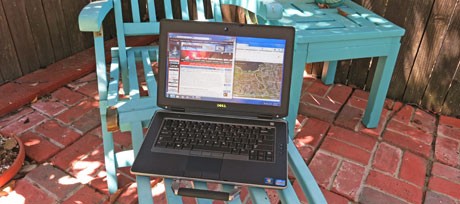
One of the big differentiating factors in ruggedized mobile computers is how well the display is suited for work outdoors in bright daylight and in direct sunlight. This can make the difference between a device being useful and productivity-enhancing, or frustrating and nearly useless.
Why is this such a big issue? Aren't today's displays so good that the only thing that matters is how large a display you want, and perhaps what resolution it should have? For indoor use that's true, but outdoors it's an entirely different story.
The outdoor viewability problem
Overall, LCD displays have come a very long way in the last two decades. If you're old enough, you probably remember those very small notebook displays that you could barely read. And if you looked at them from an angle, the color—if you had color—shifted in weird ways. Almost all of today's LCD displays are terrific. They are bright and sharp and vibrant, and you can view them from almost any angle (and depending on the technology, from all angles). Most of today's tablet and notebook displays are so good that it's hard to imagine they could get any better.
Until you take them outdoors, that is.
The difference between indoors and outdoors is amazing. A screen that is bright indoors will almost wash out when you take it outdoors on a sunny day. That's because even a very strong backlight is no match for the sun. Even very good displays become almost unreadable when they are facing the sun. The contrast goes away, the screen may go dark or it may become so reflective that it can't be used anymore. Some displays also assume strange hues and casts and colors when in the sun. Others have a shimmering iridescent look that distracts the eye. And resistive touch screens have a slightly yielding top surface that can make for optical distortions that can be very distracting.
Matte and glossy displays
Most notebook and tablet displays these days are very glossy. That's a trend that started perhaps a decade ago in Japan where vendors hoped bright, glossy screens would be more easily noticed in crowded electronics shop windows. 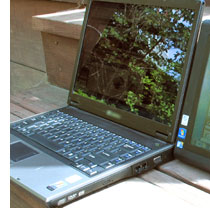 Another argument for glossy displays was that they make the picture "pop" with rich color and sharp contrast when watching video or movies. That probably depends on the individual viewer, but overall glossy screens work well enough indoors (where there are few reflections) that virtually all manufacturers switched to them. Outdoors where there are a lot of reflections, glossy displays can be very hard to view.
Another argument for glossy displays was that they make the picture "pop" with rich color and sharp contrast when watching video or movies. That probably depends on the individual viewer, but overall glossy screens work well enough indoors (where there are few reflections) that virtually all manufacturers switched to them. Outdoors where there are a lot of reflections, glossy displays can be very hard to view.
Some tablets and notebooks have matte screens or they have anti-glare coatings. 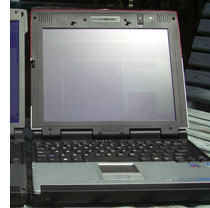 A "matte" surface can be achieved via a liquid coating with tiny particles that then diffuse light, chemical etching that makes for a rougher surface, or mechanical abrasion. The much reduced intensity of light reflection makes matte surfaces ideal for office workers. You'd think that matte displays are also the answer for good outdoor viewability, and matte displays can indeed handle reflections much better outdoors as well. The problem, though, is that matte screens, especially older ones, just diffuse the light. When that happens outdoors where light can be very strong, the screen can turn milky and becomes hard or impossible to read.
A "matte" surface can be achieved via a liquid coating with tiny particles that then diffuse light, chemical etching that makes for a rougher surface, or mechanical abrasion. The much reduced intensity of light reflection makes matte surfaces ideal for office workers. You'd think that matte displays are also the answer for good outdoor viewability, and matte displays can indeed handle reflections much better outdoors as well. The problem, though, is that matte screens, especially older ones, just diffuse the light. When that happens outdoors where light can be very strong, the screen can turn milky and becomes hard or impossible to read.
The different display technologies
Most of today's standard LCDs are transmissive, which means that you have a backlight behind the LCD. This approach works great indoors because the ratio between the strength of the backlight and the reflected ambient light is very large. Outdoors, the ambient light is much stronger, and so the ratio between the strength of the backlight and the amount of reflected light is much smaller, which means there is much less contrast.
In the past, notebook manufacturers tried different approaches to make the screens readable outdoors.
One approach was to use reflective LCDs instead of transmissive ones. This way, the brighter the sunlight, the more readable the display becomes. This never caught on for two reasons. First, since you couldn't use a backlight, you needed a sidelight to make the screen viewable indoors. That just doesn't work with displays larger than those in a PDA. Second, even outdoors, the screens looked flat because the LCD background was greenish-brown, and not white.
Another approach was "transflective" screens. Transflective screens were part transmissive so that you could use a backlight, but also part reflective so you could see them outdoors. This was supposed to be the best of both worlds, but it was really just a compromise that didn't work very well. So early transflective display technology was abandoned.
Today, most outdoor displays use what one might call modified standard transmissive technology. These screens perform just like standard transmissive displays indoors, while controlling reflections and preserving contrast outdoors. They do that with various tricks and technologies such as optical coatings, layer bonding, and circular polarizers to reduce reflected light. The overall goal of all these measures is to control distracting reflections and to get the best possible screen contrast. That's because for keeping a display readable outdoors and in sunlight, preserving display contrast is more important than anything else. That's where effective contrast comes into play.
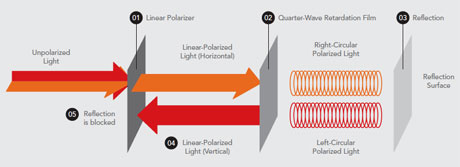
Getac's QuadraClear brochure shows the effect of linear and circular polarizers
Almost all major manufacturers of ruggedized mobile technologies have their own special approaches such as "QuadraClear" (Getac), "CircuLumin" (Panasonic), "MaxView" (Handheld Group), "xView Pro" (MobileDemand), "View Anywhere" (Motion Computing), IllumiView (Juniper Systems), "AllVue" (Xplore Technologies), and more.
What matters is effective contrast
There are various definitions of contrast. The most important one in outdoor displays is the "effective" contrast ratio, which doesn't deal with the annoying mirror-like reflections glossy screens are infamous for, but rather with the sum-total of the light reflected by the various layers a typical LCD assembly consists of. The effective contrast ratio is the ratio between that reflected light and the light generated by the display's own backlight.
There are, in essence, two major ways to control those internal reflections. One is adding circular polarizers that combines a linear polarizer and a retardation film to block reflected light. The other is bonding together layers of the LCD assembly, thus eliminating two reflecting surfaces with every bond. How well it all works depends on exactly how these elements are combined to produce the best possible effect, and that's generally a closely-guarded secret.
A rule-of-thumb formula to compute the effective contrast ratio of an LCD screen used outdoor is 1 + emitted light divided by reflected light. For emitted light we use the backlight, measured in nits. For reflected light we multiply moderate sunlight, which is the equivalent of about 10,000 nits, with the percentage of light reflected by the display. A normal, untreated notebook screen reflects about 2% of sunlight. A combination of optical coatings can bring that number down to about half a percent for displays without touch screens, and about 0.9% for displays with (resistive) touch screens.
If you use this formula and plug in the numbers, you find that a standard notebook without any optical treatments has an effective contrast ratio of about 2:1, which means it's pretty much unreadable outdoors. If you boost the backlight or apply optical coatings, the contrast ratio goes up to about 6:1, which is the minimum the military requires in its computers. If you boost the backlight AND apply coating, you get contrast ratios of about 6 or 7 for displays with resistive touch, and up to 11 or 12 without.
The bottom line with this sort of "modified transmissive" displays is that there are a number of factors that affect the effective contrast ratio and thus display viewability outdoors. It all boils down to the best possible combination of optical coatings and layer manipulations to reduce internal reflection, and a good strong backlight.
Super-bright backlights
If that is so, then why not just have the strongest possible backlight? That is indeed one good way to boost the viewability of an outdoor display, but it comes at the cost of either a larger, heavier battery or less battery life. There are ways to minimize the extra drain on the battery, one being a light sensor that will throttle the backlight whenever full brightness is not needed, and another the presence of an easily accessible "boost" button that lets the user turn extra brightness on or off.
If you're wondering how backlights are measured, an often used unit is nit. The official definition of a nit is that it is "a unit of illuminative brightness equal to one candle per square meter, measured perpendicular to the rays of the source." Most consumer notebooks and tablets are in the 200 nit range, most semi-rugged and rugged device designated as "outdoor-viewable" are in to 500-700 nit range, and some "sunlight-viewable" screens go all the way to 1,000-1,500 nit.
Does a touch screen impact outdoor viewability
If it is resistive touch, yes, it usually does make a difference. That's because light reflects on every surface of the LCD assembly, and resistive touch adds additional surfaces, therefore lowering the effective contrast ratio. Another problem is that the soft, yielding surface of resistive touch screens results in distorted reflections that are not present in totally smooth glass surfaces.Capacitive touch, which is increasingly used even in rugged devices, doesn't have this problem. However, it always pays to closely examine the display under all all sorts of extreme lighting conditions as some non-resistive technologies can have distracting grid patterns that become visible outdoors.
Hybrid approaches
In addition to reflective, transflective and transmissive screens and the various ways to tweak them for better outdoor performance, there are some interesting hybrid approaches. One of them is Pixel Qi's enhanced transflective technology where display pixels consist of a transmissive and a reflective part that have separate drivers. In essence, that allows them to have a "triple mode" display that can use one or both technologies, depending on the lighting situation. A while ago, RuggedPCReview had the opportunity to examine the Pixel Qi technology in a detailed review (see here), and we concluded that the technology absolutely works. However, potential users need to be aware of its inherent gradual switching from full color indoors to muted color outdoors and black and white in direct sunlight as that may affect color-dependent apps.
Most recently, Pixel Qi has come out with displays that do show colors in direct-sunlight reflective mode, but we have not have hands-on with any of those yet. Also of note is that Pixel Qi's founder and chief technology officer left the company early 2013 to work on the Google Glass project, and that's not good news for Pixel Qi.
How about OLED?
What about the OLED/AMOLED technology that is touted as the next big thing in flatscreen TVs, better than either LCD or Plasma? OLED screens have been used in some cameras, phones and even scuba diving computers for a while now, but I can't see them as a candidate for sunlight-viewable displays. That's because OLED technology is essentially a grid of special LEDs that easily washes out in sunlight or even bright daylight.
Other important considerations
On top of using the best possible outdoor-viewable display available for a given job, you also want good underlying LCD technology and good optics. A wide viewing angle makes the display easier to read, and we always strongly suggest starting with an IPS (In-Plane Switching, see Wiki) or, better yet, an AFFS (Advanced Fringe Field Switching, see wiki) screen so that viewing angles and color shifts simply aren't an issue. Some anti-glare coatings can create annoying reflections that can trick your brain into filling in detail, which makes the screen even less readable than it would be without the coating. You also don't want a display that reflects distorted images. That again confuses your brain and makes the screen harder to read. And you want a display that is as resistant to fingerprints as possible because fingerprints can become enormously visible and distracting under certain outdoor lighting conditions.
Examples from RuggedPCReview.com testing
Below are examples from RuggedPCReview testing that illustrate some of the issues and properties discussed:
Below: The first image shows pretty much how the modern era of optically treated transmissive displays got started around 2007 when Itronix introduced their DynaVue outdoor-readable display technology. The image shows how DynaVue compared to an earlier non-DynaVue Itronix notebook.
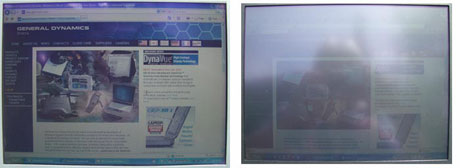
Below: All of a sudden it was possible to control reflection to an extent where displays remained viewable in direct sunlight. An older Itronix notebook with a matte display surface, by comparison, diffuses the sunlight so much that the screen is totally blown out.
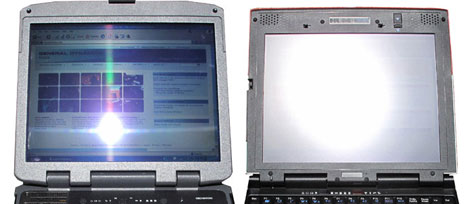
Below: Unbeknownst to most, Dell was another pioneer with optically treated outdoor-viewable displays. In 2007, a Dell Latitude ATG 630 with its 500-nit backlight offered excellent outdoor viewability with an 11:1 effective contrast ratio. Dell did that by bonding a piece of glass on the polarizer film, thus eliminating the polarizer film's reflectivity, and then treating the smooth exterior surface of the glass.
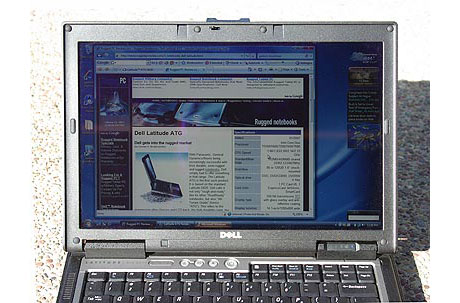
Below: Comparison between a "modern-style" optically treated transmissive display on an Xplore rugged tablet, and the matte display on a competing product. Indoors both tablets looked great, but outdoors the difference was obvious.
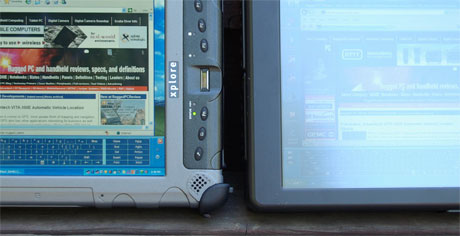
Below: The same Xplore iX104 tablet versus one of the original convertible Tablet PCs. The matte, non-treated 2002-era Toshiba Portege display simply vanishes outdoors.
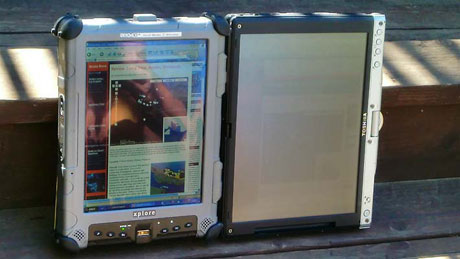
Below: Matte displays can work quite well outdoors; this DRS ARMOR tablet mutes the reflection and remains quite viewable, though you have to hunt for the right viewing angle.
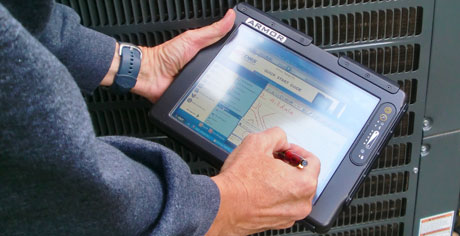
Below: That's a Getac rugged notebook on the left versus a Gateway consumer notebook with a glossy display that looked great indoors and even had decent contrast outdoors, but the glossy screen made it unusable.
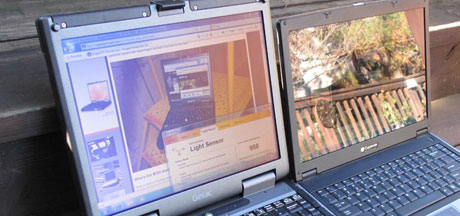
Below: A GammaTech SA14 semi-rugged notebook compared to an Apple MacBook Pro. Indoor the MacBook excels, outdoors it falls victim to reflections.
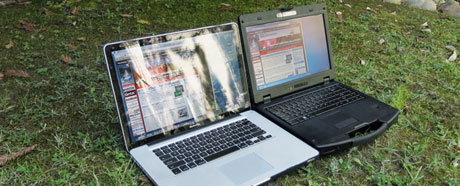
Below: Here we see how a rugged MobileDemand T7200 xTablet compares to a Google Nexus 7 consumer tablet. Same story: indoors the Nexus screen looks terrific, outdoors it's all reflections, although the display itself remains quite viewable.
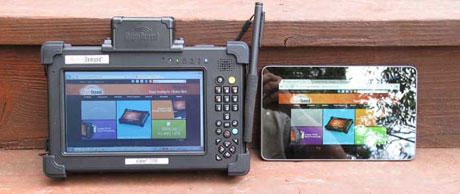
Below: Motion CL910 tablet vs. iPad 3—the iPad's retina display is terrific and is even viewable outdoors, but the super-glossy surface is very prone to reflections.
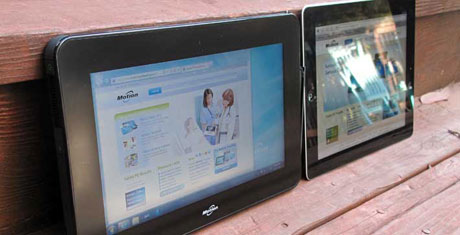
Below: MobileDemand pioneered using a modified Pixel Qi display in a rugged tablet, their xTablet T7200. Note how the display works under all lighting conditions, from indoors to direct sun where the display switches to gray-scale reflective.
![]()
Below: An example of the interesting optical properties of treated outdoor displays. The two Motion Computing tablets are both excellent outdoors, and have some of the best displays anywhere, but it's clear that they have different optical treatments.
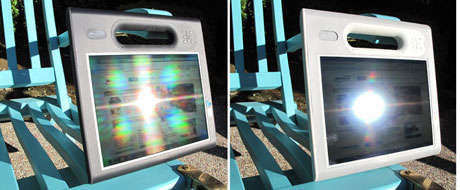
Below: Another example of the odd optical properties of some displays. This one is basically quite viewable, but the wavy, distorted reflections make it difficult to use.
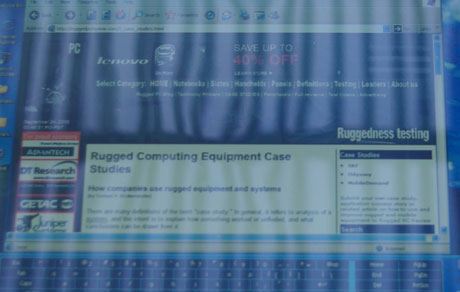
Below: An example of brute force—the Getac X500 rugged notebook has a superbright backlight that, combined with very good optical treatment, makes this one of the best displays available.
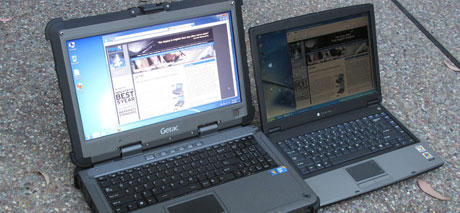
So what's the answer?
While there are a number of interesting alternative display technologies, at this point, the best overall bet is still a combination of optical treatments and coatings, direct bonding to reduce the number of reflecting surfaces, a reasonably strong backlight, and a touch technology with as little impact on display viewability as possible. The following all contribute to the best currently possible outdoor-viewable display:
- IPS or AFFS LCD (for perfect viewing angle)
- Anti-reflective and anti-glare treatments
- Circular polarizers (combination of a linear polarizer and a retardation film to block reflected light)
- Minimal number of reflective surfaces via direct bonding
- Sufficiently strong backlight
- Hard, flat surface to eliminate distortions
- Suitably high resolution
- Touch technology that does not show, distort or create optical aberrations
- Surface that's not prone to fingerprints
As is, most major vendors of rugged mobile computing technology offer outdoor/sunlight-viewable displays standard or as an option. Most perform quite well, though there are significant differences that can really only be evaluated in side-by-side comparison, as the industry does not generally disclose exactly how displays are treated. Such disclosure, and also the inclusion of effective contrast ratio into product specs would be tremendously helpful. That, of course, would require generally agreed-on standard definitions and testing procedures.
The last word in outdoor-viewable display technology has not yet been spoken, and it's more than likely that disruptive new technologies will replace what's available now. However, today's technology has reached a point where it can be good enough to allow work in bright daylight and even direct sunlight, though it definitely pays to see for yourself which particular implementation works best for any given project. -- Conrad H. Blickenstorfer, November 2013
(For the definite article on the modified transmissive approach, see "GD-Itronix DynaVue Display Technology" by Geoff Walker. It goes back to 2007, but all the principles remain valid today. Thanks also to Mr. Walker for feedback and suggestions for this article).
Posted by conradb212 at November 14, 2013 10:51 PM















